Auditing Report: Financial Analysis and Internal Controls
VerifiedAdded on 2021/06/14
|14
|3381
|29
Report
AI Summary
This auditing report provides a comprehensive financial analysis of Printer Solutions Ltd. It begins with a detailed ratio analysis, including liquidity, solvency, efficiency, and profitability ratios, spanning from 2015 to 2017. The report then addresses the going concern of the company, evaluating its financial position based on the ratio analysis. It identifies potential material misstatements in key accounts like cost of goods sold, revenue, and expenses, along with relevant assertions. Furthermore, the report examines key controls related to cash collection and revenue, proposing tests of controls for revenue from services accounts. Finally, it discusses the challenges NSW Rural Health might face when implementing a new payroll system and outlines application controls applicable to wage expenses and salaries. The analysis highlights areas of financial risk and the importance of robust internal controls.
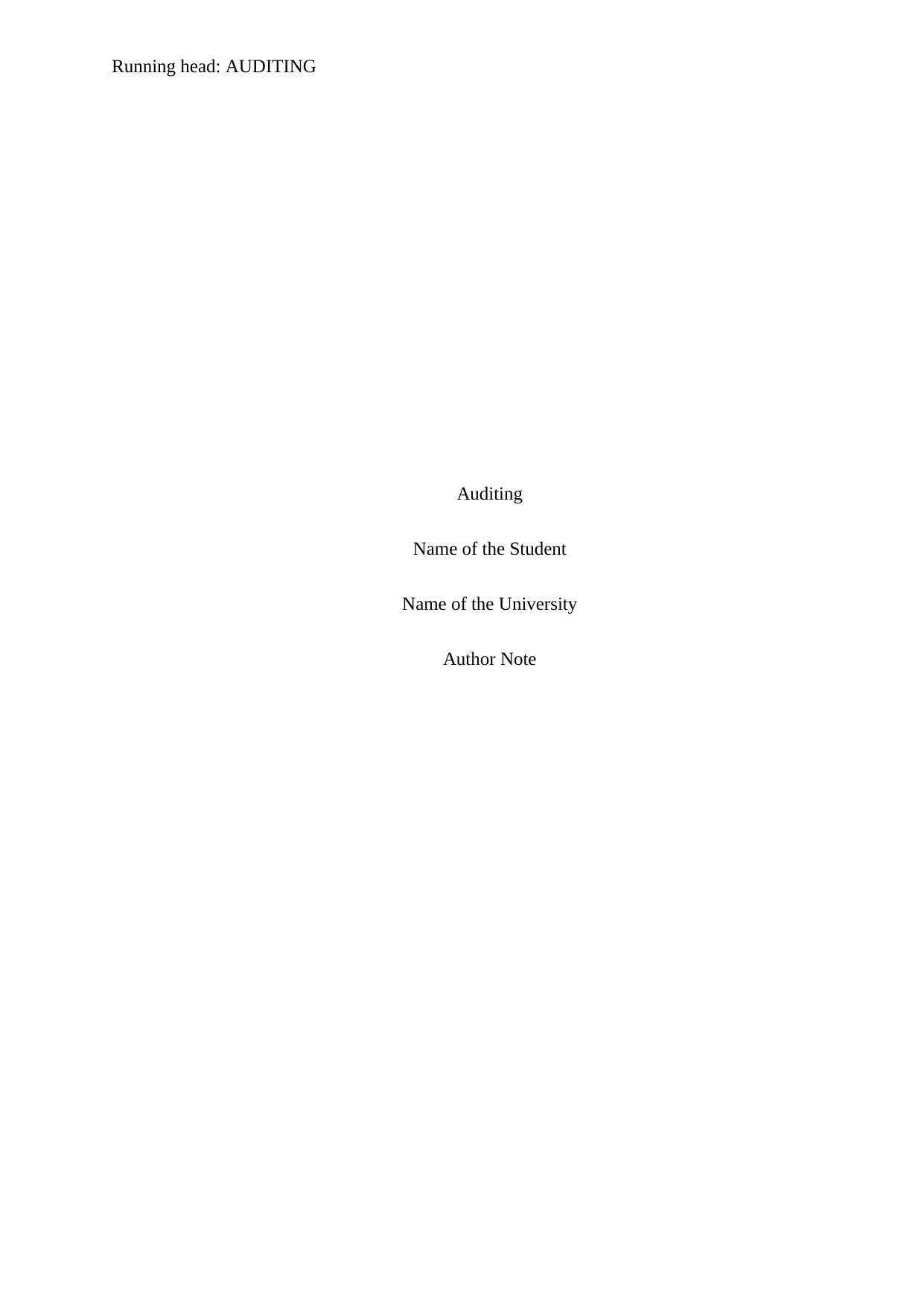
Running head: AUDITING
Auditing
Name of the Student
Name of the University
Author Note
Auditing
Name of the Student
Name of the University
Author Note
Paraphrase This Document
Need a fresh take? Get an instant paraphrase of this document with our AI Paraphraser
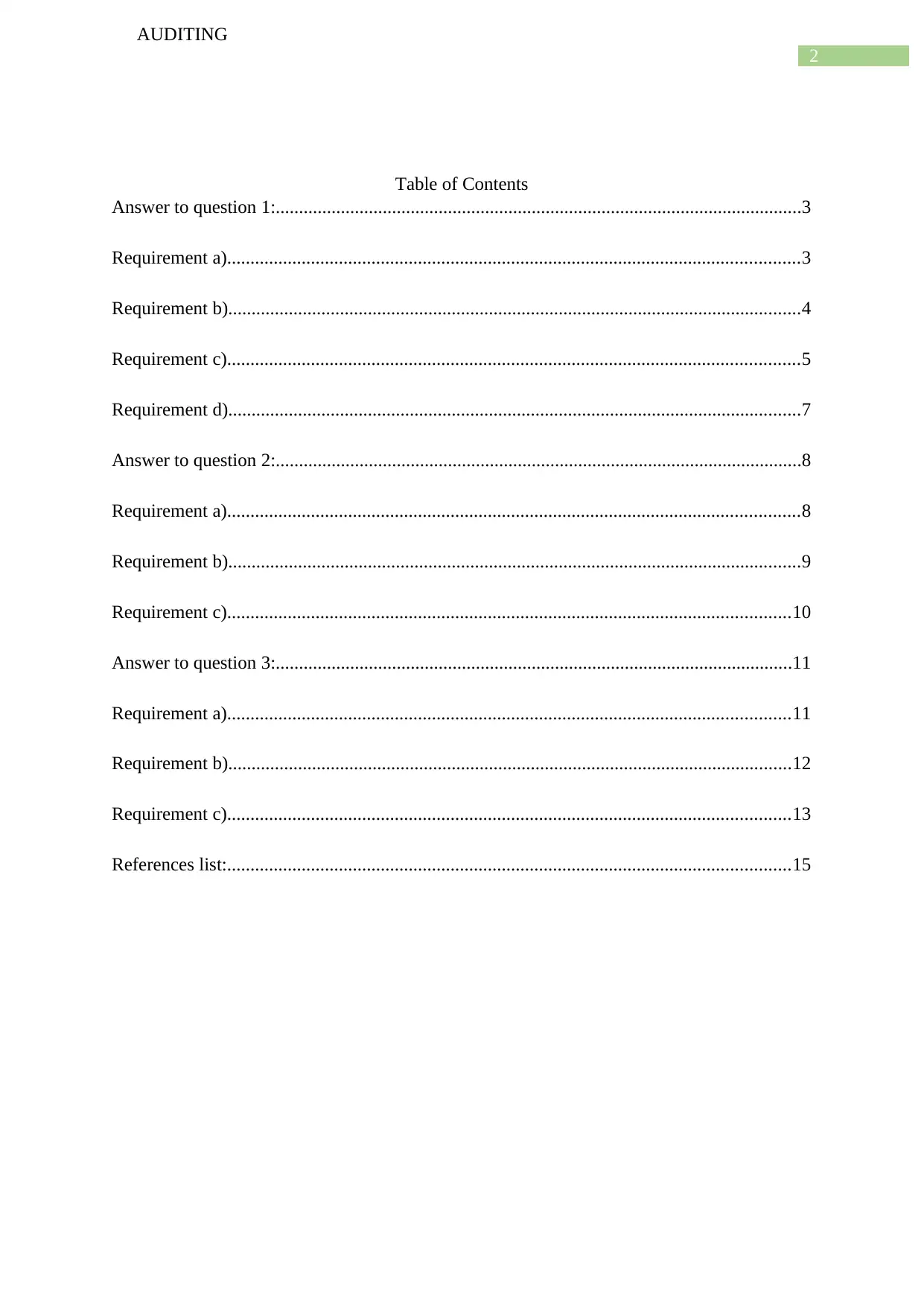
2
AUDITING
Table of Contents
Answer to question 1:.................................................................................................................3
Requirement a)...........................................................................................................................3
Requirement b)...........................................................................................................................4
Requirement c)...........................................................................................................................5
Requirement d)...........................................................................................................................7
Answer to question 2:.................................................................................................................8
Requirement a)...........................................................................................................................8
Requirement b)...........................................................................................................................9
Requirement c).........................................................................................................................10
Answer to question 3:...............................................................................................................11
Requirement a).........................................................................................................................11
Requirement b).........................................................................................................................12
Requirement c).........................................................................................................................13
References list:.........................................................................................................................15
AUDITING
Table of Contents
Answer to question 1:.................................................................................................................3
Requirement a)...........................................................................................................................3
Requirement b)...........................................................................................................................4
Requirement c)...........................................................................................................................5
Requirement d)...........................................................................................................................7
Answer to question 2:.................................................................................................................8
Requirement a)...........................................................................................................................8
Requirement b)...........................................................................................................................9
Requirement c).........................................................................................................................10
Answer to question 3:...............................................................................................................11
Requirement a).........................................................................................................................11
Requirement b).........................................................................................................................12
Requirement c).........................................................................................................................13
References list:.........................................................................................................................15
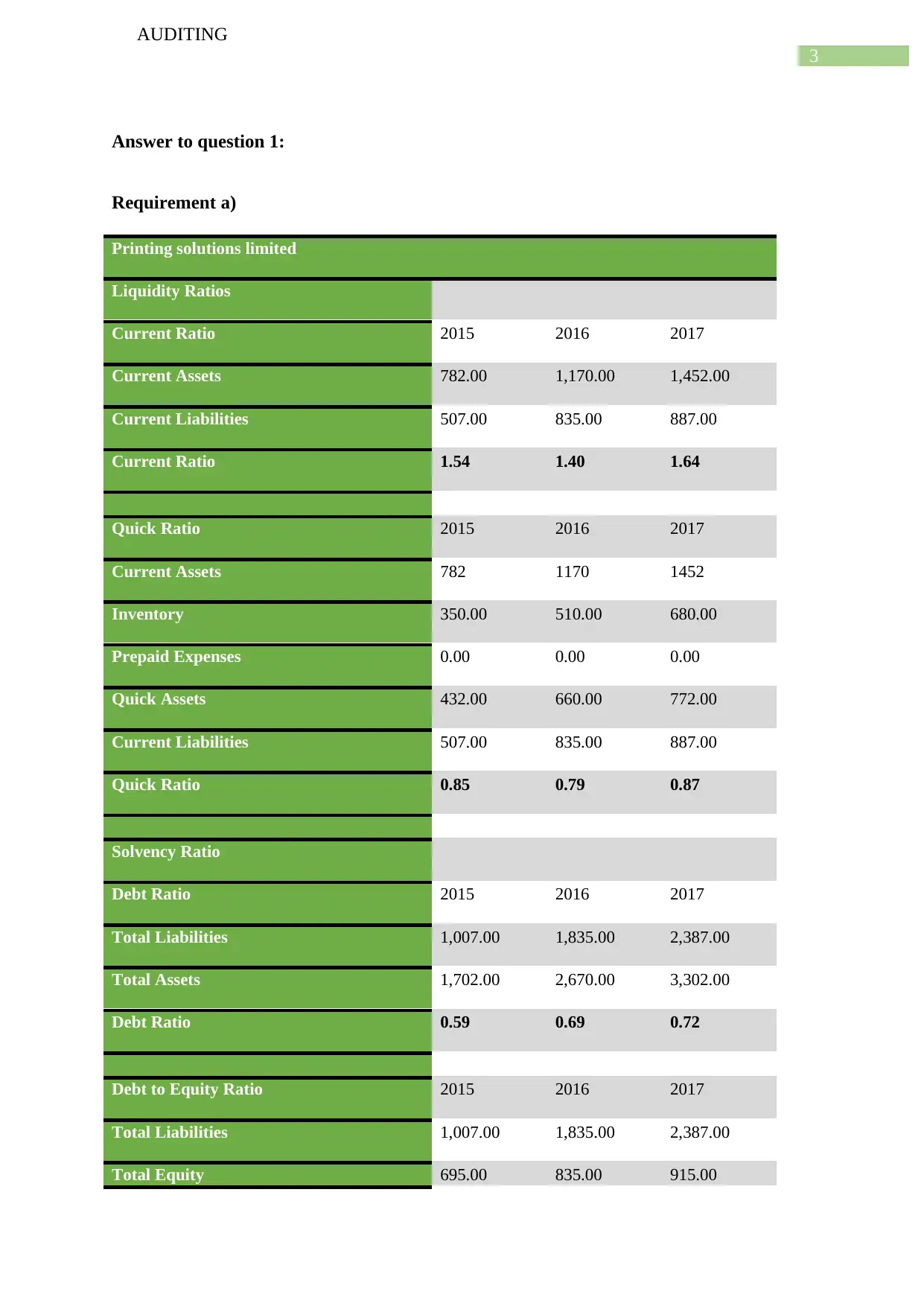
3
AUDITING
Answer to question 1:
Requirement a)
Printing solutions limited
Liquidity Ratios
Current Ratio 2015 2016 2017
Current Assets 782.00 1,170.00 1,452.00
Current Liabilities 507.00 835.00 887.00
Current Ratio 1.54 1.40 1.64
Quick Ratio 2015 2016 2017
Current Assets 782 1170 1452
Inventory 350.00 510.00 680.00
Prepaid Expenses 0.00 0.00 0.00
Quick Assets 432.00 660.00 772.00
Current Liabilities 507.00 835.00 887.00
Quick Ratio 0.85 0.79 0.87
Solvency Ratio
Debt Ratio 2015 2016 2017
Total Liabilities 1,007.00 1,835.00 2,387.00
Total Assets 1,702.00 2,670.00 3,302.00
Debt Ratio 0.59 0.69 0.72
Debt to Equity Ratio 2015 2016 2017
Total Liabilities 1,007.00 1,835.00 2,387.00
Total Equity 695.00 835.00 915.00
AUDITING
Answer to question 1:
Requirement a)
Printing solutions limited
Liquidity Ratios
Current Ratio 2015 2016 2017
Current Assets 782.00 1,170.00 1,452.00
Current Liabilities 507.00 835.00 887.00
Current Ratio 1.54 1.40 1.64
Quick Ratio 2015 2016 2017
Current Assets 782 1170 1452
Inventory 350.00 510.00 680.00
Prepaid Expenses 0.00 0.00 0.00
Quick Assets 432.00 660.00 772.00
Current Liabilities 507.00 835.00 887.00
Quick Ratio 0.85 0.79 0.87
Solvency Ratio
Debt Ratio 2015 2016 2017
Total Liabilities 1,007.00 1,835.00 2,387.00
Total Assets 1,702.00 2,670.00 3,302.00
Debt Ratio 0.59 0.69 0.72
Debt to Equity Ratio 2015 2016 2017
Total Liabilities 1,007.00 1,835.00 2,387.00
Total Equity 695.00 835.00 915.00
⊘ This is a preview!⊘
Do you want full access?
Subscribe today to unlock all pages.

Trusted by 1+ million students worldwide
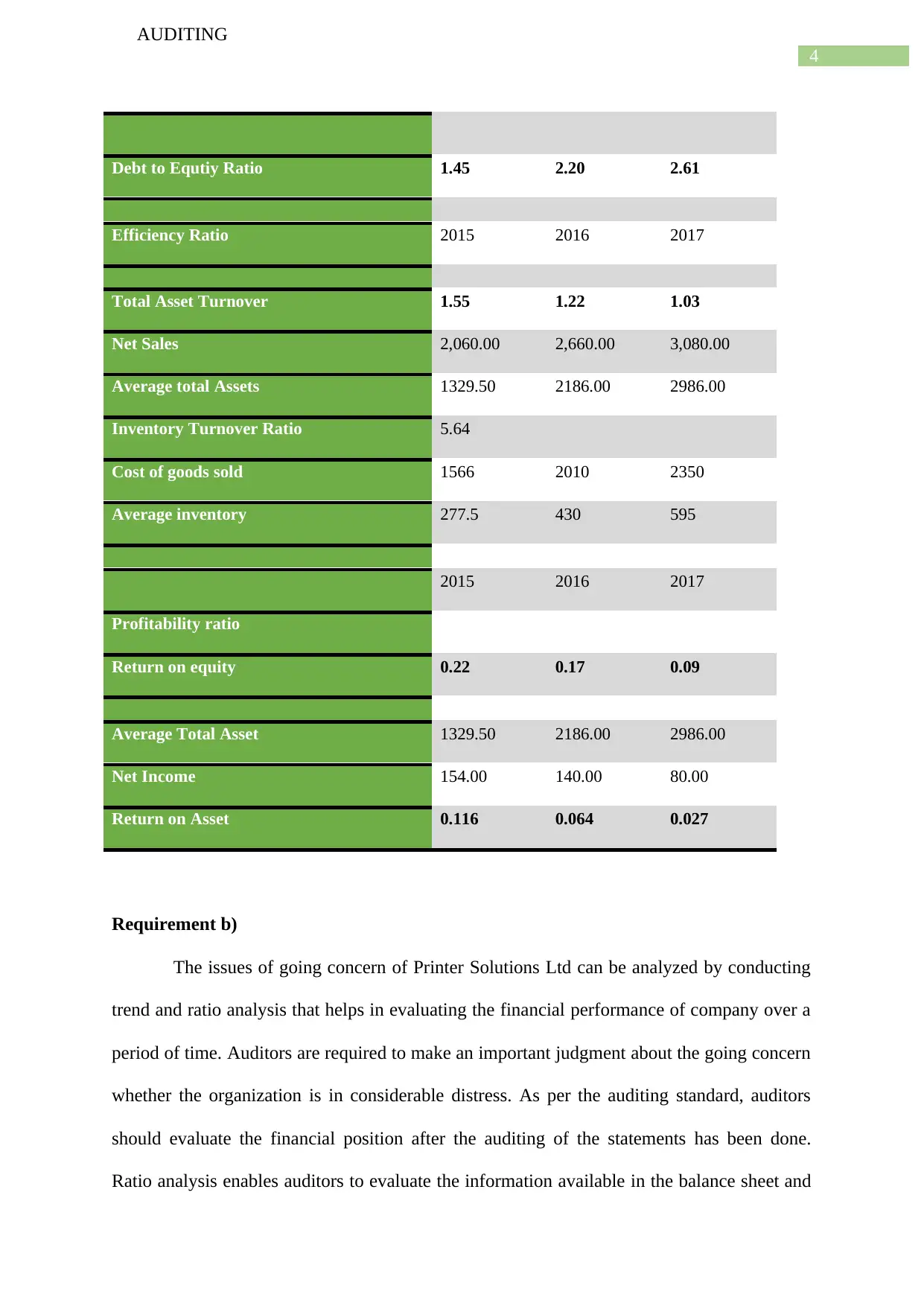
4
AUDITING
Debt to Equtiy Ratio 1.45 2.20 2.61
Efficiency Ratio 2015 2016 2017
Total Asset Turnover 1.55 1.22 1.03
Net Sales 2,060.00 2,660.00 3,080.00
Average total Assets 1329.50 2186.00 2986.00
Inventory Turnover Ratio 5.64
Cost of goods sold 1566 2010 2350
Average inventory 277.5 430 595
2015 2016 2017
Profitability ratio
Return on equity 0.22 0.17 0.09
Average Total Asset 1329.50 2186.00 2986.00
Net Income 154.00 140.00 80.00
Return on Asset 0.116 0.064 0.027
Requirement b)
The issues of going concern of Printer Solutions Ltd can be analyzed by conducting
trend and ratio analysis that helps in evaluating the financial performance of company over a
period of time. Auditors are required to make an important judgment about the going concern
whether the organization is in considerable distress. As per the auditing standard, auditors
should evaluate the financial position after the auditing of the statements has been done.
Ratio analysis enables auditors to evaluate the information available in the balance sheet and
AUDITING
Debt to Equtiy Ratio 1.45 2.20 2.61
Efficiency Ratio 2015 2016 2017
Total Asset Turnover 1.55 1.22 1.03
Net Sales 2,060.00 2,660.00 3,080.00
Average total Assets 1329.50 2186.00 2986.00
Inventory Turnover Ratio 5.64
Cost of goods sold 1566 2010 2350
Average inventory 277.5 430 595
2015 2016 2017
Profitability ratio
Return on equity 0.22 0.17 0.09
Average Total Asset 1329.50 2186.00 2986.00
Net Income 154.00 140.00 80.00
Return on Asset 0.116 0.064 0.027
Requirement b)
The issues of going concern of Printer Solutions Ltd can be analyzed by conducting
trend and ratio analysis that helps in evaluating the financial performance of company over a
period of time. Auditors are required to make an important judgment about the going concern
whether the organization is in considerable distress. As per the auditing standard, auditors
should evaluate the financial position after the auditing of the statements has been done.
Ratio analysis enables auditors to evaluate the information available in the balance sheet and
Paraphrase This Document
Need a fresh take? Get an instant paraphrase of this document with our AI Paraphraser
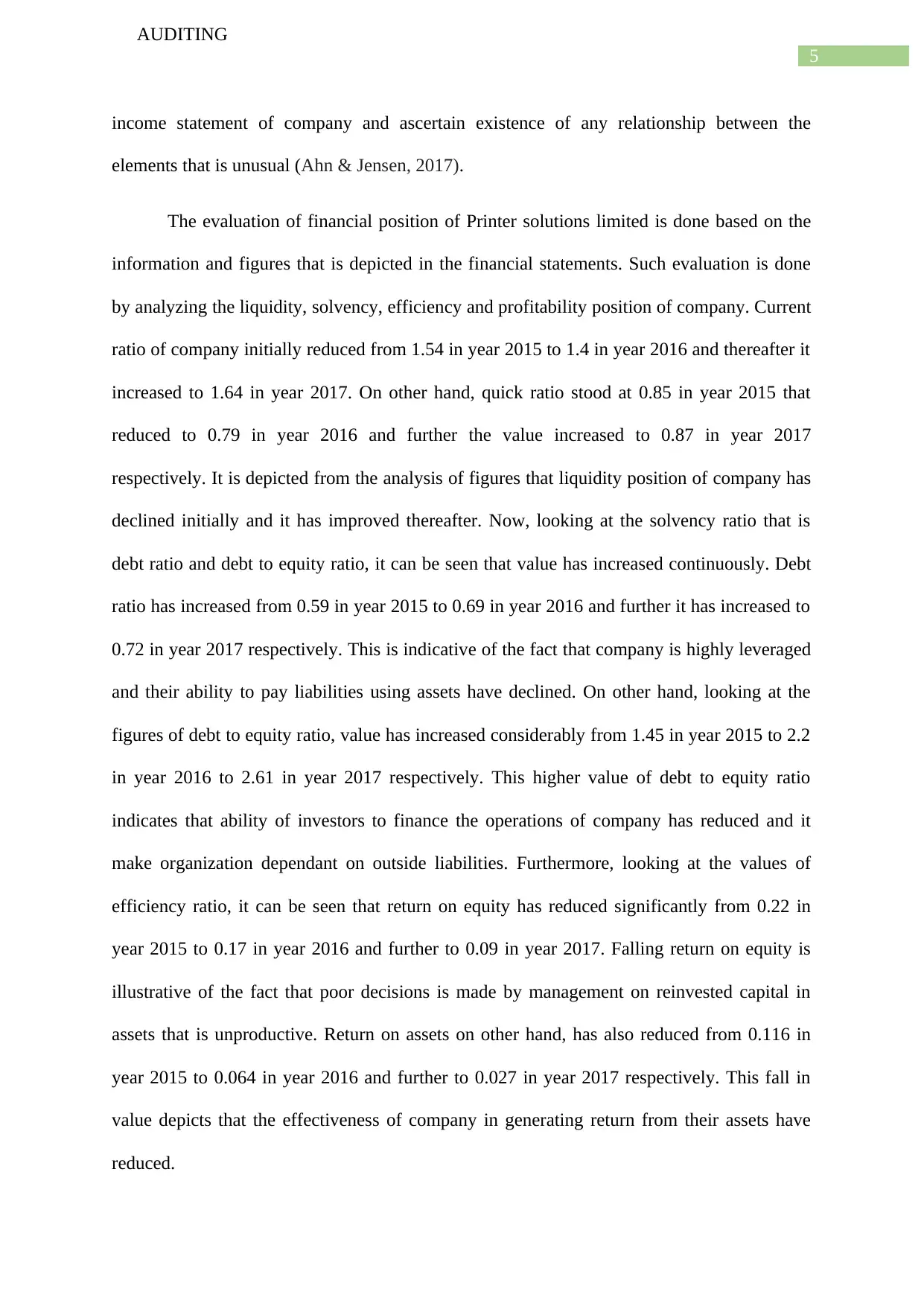
5
AUDITING
income statement of company and ascertain existence of any relationship between the
elements that is unusual (Ahn & Jensen, 2017).
The evaluation of financial position of Printer solutions limited is done based on the
information and figures that is depicted in the financial statements. Such evaluation is done
by analyzing the liquidity, solvency, efficiency and profitability position of company. Current
ratio of company initially reduced from 1.54 in year 2015 to 1.4 in year 2016 and thereafter it
increased to 1.64 in year 2017. On other hand, quick ratio stood at 0.85 in year 2015 that
reduced to 0.79 in year 2016 and further the value increased to 0.87 in year 2017
respectively. It is depicted from the analysis of figures that liquidity position of company has
declined initially and it has improved thereafter. Now, looking at the solvency ratio that is
debt ratio and debt to equity ratio, it can be seen that value has increased continuously. Debt
ratio has increased from 0.59 in year 2015 to 0.69 in year 2016 and further it has increased to
0.72 in year 2017 respectively. This is indicative of the fact that company is highly leveraged
and their ability to pay liabilities using assets have declined. On other hand, looking at the
figures of debt to equity ratio, value has increased considerably from 1.45 in year 2015 to 2.2
in year 2016 to 2.61 in year 2017 respectively. This higher value of debt to equity ratio
indicates that ability of investors to finance the operations of company has reduced and it
make organization dependant on outside liabilities. Furthermore, looking at the values of
efficiency ratio, it can be seen that return on equity has reduced significantly from 0.22 in
year 2015 to 0.17 in year 2016 and further to 0.09 in year 2017. Falling return on equity is
illustrative of the fact that poor decisions is made by management on reinvested capital in
assets that is unproductive. Return on assets on other hand, has also reduced from 0.116 in
year 2015 to 0.064 in year 2016 and further to 0.027 in year 2017 respectively. This fall in
value depicts that the effectiveness of company in generating return from their assets have
reduced.
AUDITING
income statement of company and ascertain existence of any relationship between the
elements that is unusual (Ahn & Jensen, 2017).
The evaluation of financial position of Printer solutions limited is done based on the
information and figures that is depicted in the financial statements. Such evaluation is done
by analyzing the liquidity, solvency, efficiency and profitability position of company. Current
ratio of company initially reduced from 1.54 in year 2015 to 1.4 in year 2016 and thereafter it
increased to 1.64 in year 2017. On other hand, quick ratio stood at 0.85 in year 2015 that
reduced to 0.79 in year 2016 and further the value increased to 0.87 in year 2017
respectively. It is depicted from the analysis of figures that liquidity position of company has
declined initially and it has improved thereafter. Now, looking at the solvency ratio that is
debt ratio and debt to equity ratio, it can be seen that value has increased continuously. Debt
ratio has increased from 0.59 in year 2015 to 0.69 in year 2016 and further it has increased to
0.72 in year 2017 respectively. This is indicative of the fact that company is highly leveraged
and their ability to pay liabilities using assets have declined. On other hand, looking at the
figures of debt to equity ratio, value has increased considerably from 1.45 in year 2015 to 2.2
in year 2016 to 2.61 in year 2017 respectively. This higher value of debt to equity ratio
indicates that ability of investors to finance the operations of company has reduced and it
make organization dependant on outside liabilities. Furthermore, looking at the values of
efficiency ratio, it can be seen that return on equity has reduced significantly from 0.22 in
year 2015 to 0.17 in year 2016 and further to 0.09 in year 2017. Falling return on equity is
illustrative of the fact that poor decisions is made by management on reinvested capital in
assets that is unproductive. Return on assets on other hand, has also reduced from 0.116 in
year 2015 to 0.064 in year 2016 and further to 0.027 in year 2017 respectively. This fall in
value depicts that the effectiveness of company in generating return from their assets have
reduced.

6
AUDITING
Requirement c)
The account balances of Printer solutions Ltd that could potentially be materially
misstated are as follows:
Cost of goods sold account- The cost of goods sold of Printer solutions has increased
year on year as evident from the income statement. There is considerable increase in cost of
goods sold to 2350 in year 2017 as against 1566 in year 2015. It can be inferred that this
considerable increase in cost of goods sold might indicate that there might be overstatement
of charges and credit for amount that is transferred to work in progress and finished goods.
Revenue account- The occurrence of fraud in financial statements of company might
depict that revenue account is materially misstated. If the organization is making excess
amount of sales in relation to production capacity, it might be certain that there will be
recording of fictitious assets (Bills et al., 2015). Trend analysis indicates that in year 2017,
the volume of sales has increased by 15.79%. This could indicate that for returning goods,
there might be some agreements that is not disclosed with customers.
Expenses account- The expenses account has the certainty of being under or over
stated. Liabilities might be under recorded and there might not be proper inclusion of
invoices relating to expenses. Increased funding generated from cash flow and loan facility
might be used for covering increased expenses of company (Trotman et al., 2015). In recent
year, expenses have reduced as depicted from figures.
Requirement d)
Assertions are considered as management claim concerning certain business aspects.
For different types of material misstatement relating to account balances, some assertions are
made by authors.
AUDITING
Requirement c)
The account balances of Printer solutions Ltd that could potentially be materially
misstated are as follows:
Cost of goods sold account- The cost of goods sold of Printer solutions has increased
year on year as evident from the income statement. There is considerable increase in cost of
goods sold to 2350 in year 2017 as against 1566 in year 2015. It can be inferred that this
considerable increase in cost of goods sold might indicate that there might be overstatement
of charges and credit for amount that is transferred to work in progress and finished goods.
Revenue account- The occurrence of fraud in financial statements of company might
depict that revenue account is materially misstated. If the organization is making excess
amount of sales in relation to production capacity, it might be certain that there will be
recording of fictitious assets (Bills et al., 2015). Trend analysis indicates that in year 2017,
the volume of sales has increased by 15.79%. This could indicate that for returning goods,
there might be some agreements that is not disclosed with customers.
Expenses account- The expenses account has the certainty of being under or over
stated. Liabilities might be under recorded and there might not be proper inclusion of
invoices relating to expenses. Increased funding generated from cash flow and loan facility
might be used for covering increased expenses of company (Trotman et al., 2015). In recent
year, expenses have reduced as depicted from figures.
Requirement d)
Assertions are considered as management claim concerning certain business aspects.
For different types of material misstatement relating to account balances, some assertions are
made by authors.
⊘ This is a preview!⊘
Do you want full access?
Subscribe today to unlock all pages.

Trusted by 1+ million students worldwide
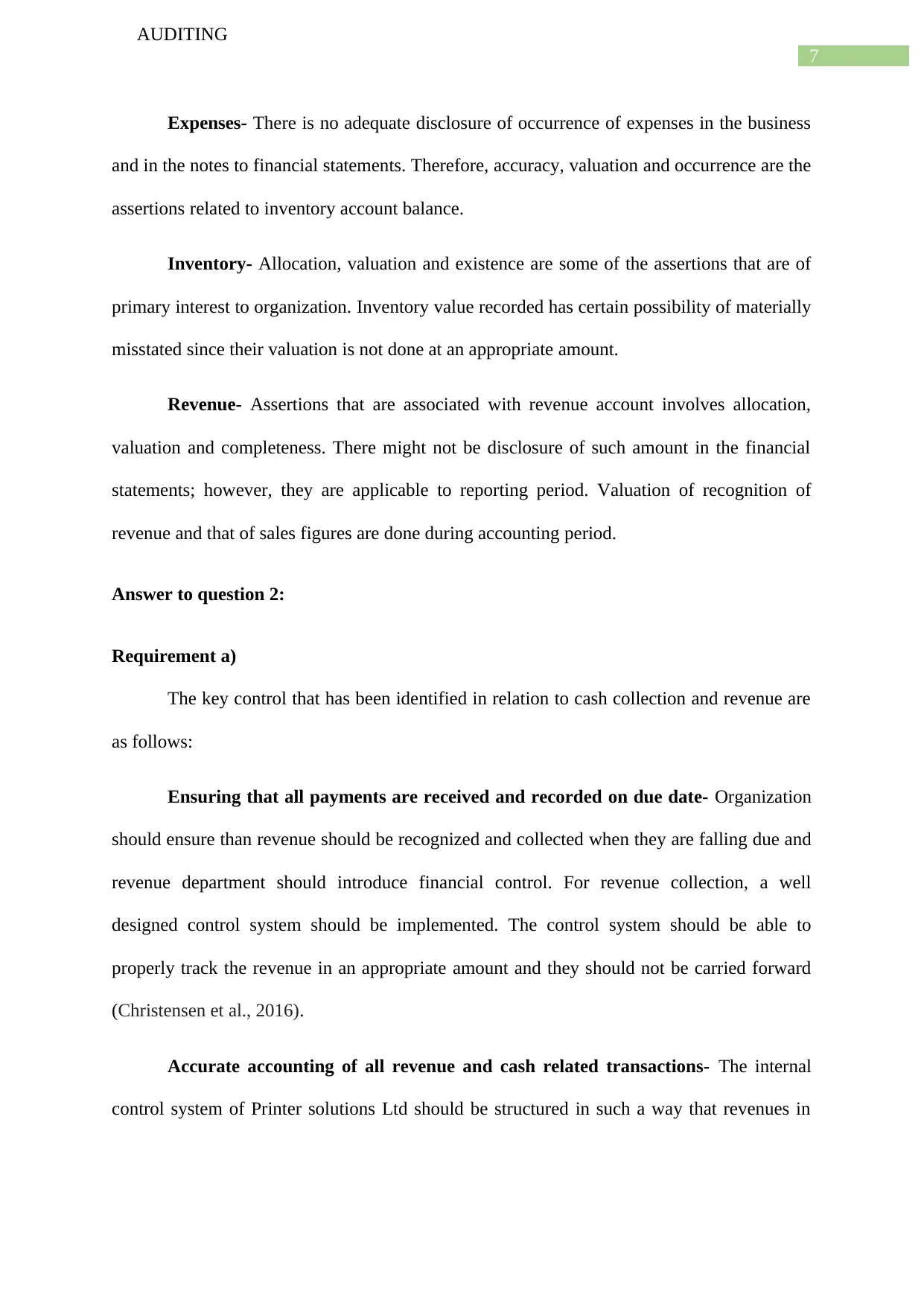
7
AUDITING
Expenses- There is no adequate disclosure of occurrence of expenses in the business
and in the notes to financial statements. Therefore, accuracy, valuation and occurrence are the
assertions related to inventory account balance.
Inventory- Allocation, valuation and existence are some of the assertions that are of
primary interest to organization. Inventory value recorded has certain possibility of materially
misstated since their valuation is not done at an appropriate amount.
Revenue- Assertions that are associated with revenue account involves allocation,
valuation and completeness. There might not be disclosure of such amount in the financial
statements; however, they are applicable to reporting period. Valuation of recognition of
revenue and that of sales figures are done during accounting period.
Answer to question 2:
Requirement a)
The key control that has been identified in relation to cash collection and revenue are
as follows:
Ensuring that all payments are received and recorded on due date- Organization
should ensure than revenue should be recognized and collected when they are falling due and
revenue department should introduce financial control. For revenue collection, a well
designed control system should be implemented. The control system should be able to
properly track the revenue in an appropriate amount and they should not be carried forward
(Christensen et al., 2016).
Accurate accounting of all revenue and cash related transactions- The internal
control system of Printer solutions Ltd should be structured in such a way that revenues in
AUDITING
Expenses- There is no adequate disclosure of occurrence of expenses in the business
and in the notes to financial statements. Therefore, accuracy, valuation and occurrence are the
assertions related to inventory account balance.
Inventory- Allocation, valuation and existence are some of the assertions that are of
primary interest to organization. Inventory value recorded has certain possibility of materially
misstated since their valuation is not done at an appropriate amount.
Revenue- Assertions that are associated with revenue account involves allocation,
valuation and completeness. There might not be disclosure of such amount in the financial
statements; however, they are applicable to reporting period. Valuation of recognition of
revenue and that of sales figures are done during accounting period.
Answer to question 2:
Requirement a)
The key control that has been identified in relation to cash collection and revenue are
as follows:
Ensuring that all payments are received and recorded on due date- Organization
should ensure than revenue should be recognized and collected when they are falling due and
revenue department should introduce financial control. For revenue collection, a well
designed control system should be implemented. The control system should be able to
properly track the revenue in an appropriate amount and they should not be carried forward
(Christensen et al., 2016).
Accurate accounting of all revenue and cash related transactions- The internal
control system of Printer solutions Ltd should be structured in such a way that revenues in
Paraphrase This Document
Need a fresh take? Get an instant paraphrase of this document with our AI Paraphraser
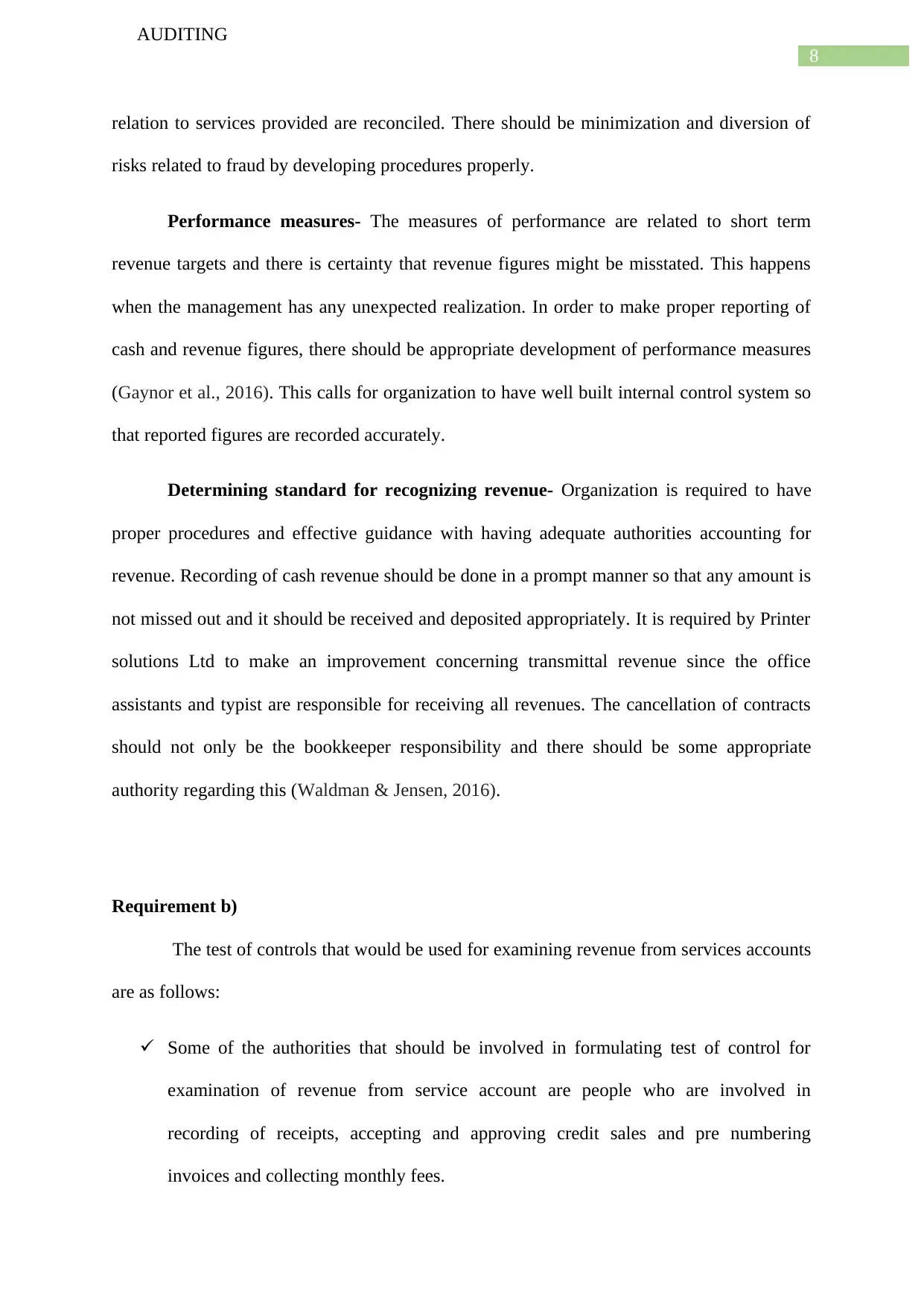
8
AUDITING
relation to services provided are reconciled. There should be minimization and diversion of
risks related to fraud by developing procedures properly.
Performance measures- The measures of performance are related to short term
revenue targets and there is certainty that revenue figures might be misstated. This happens
when the management has any unexpected realization. In order to make proper reporting of
cash and revenue figures, there should be appropriate development of performance measures
(Gaynor et al., 2016). This calls for organization to have well built internal control system so
that reported figures are recorded accurately.
Determining standard for recognizing revenue- Organization is required to have
proper procedures and effective guidance with having adequate authorities accounting for
revenue. Recording of cash revenue should be done in a prompt manner so that any amount is
not missed out and it should be received and deposited appropriately. It is required by Printer
solutions Ltd to make an improvement concerning transmittal revenue since the office
assistants and typist are responsible for receiving all revenues. The cancellation of contracts
should not only be the bookkeeper responsibility and there should be some appropriate
authority regarding this (Waldman & Jensen, 2016).
Requirement b)
The test of controls that would be used for examining revenue from services accounts
are as follows:
Some of the authorities that should be involved in formulating test of control for
examination of revenue from service account are people who are involved in
recording of receipts, accepting and approving credit sales and pre numbering
invoices and collecting monthly fees.
AUDITING
relation to services provided are reconciled. There should be minimization and diversion of
risks related to fraud by developing procedures properly.
Performance measures- The measures of performance are related to short term
revenue targets and there is certainty that revenue figures might be misstated. This happens
when the management has any unexpected realization. In order to make proper reporting of
cash and revenue figures, there should be appropriate development of performance measures
(Gaynor et al., 2016). This calls for organization to have well built internal control system so
that reported figures are recorded accurately.
Determining standard for recognizing revenue- Organization is required to have
proper procedures and effective guidance with having adequate authorities accounting for
revenue. Recording of cash revenue should be done in a prompt manner so that any amount is
not missed out and it should be received and deposited appropriately. It is required by Printer
solutions Ltd to make an improvement concerning transmittal revenue since the office
assistants and typist are responsible for receiving all revenues. The cancellation of contracts
should not only be the bookkeeper responsibility and there should be some appropriate
authority regarding this (Waldman & Jensen, 2016).
Requirement b)
The test of controls that would be used for examining revenue from services accounts
are as follows:
Some of the authorities that should be involved in formulating test of control for
examination of revenue from service account are people who are involved in
recording of receipts, accepting and approving credit sales and pre numbering
invoices and collecting monthly fees.
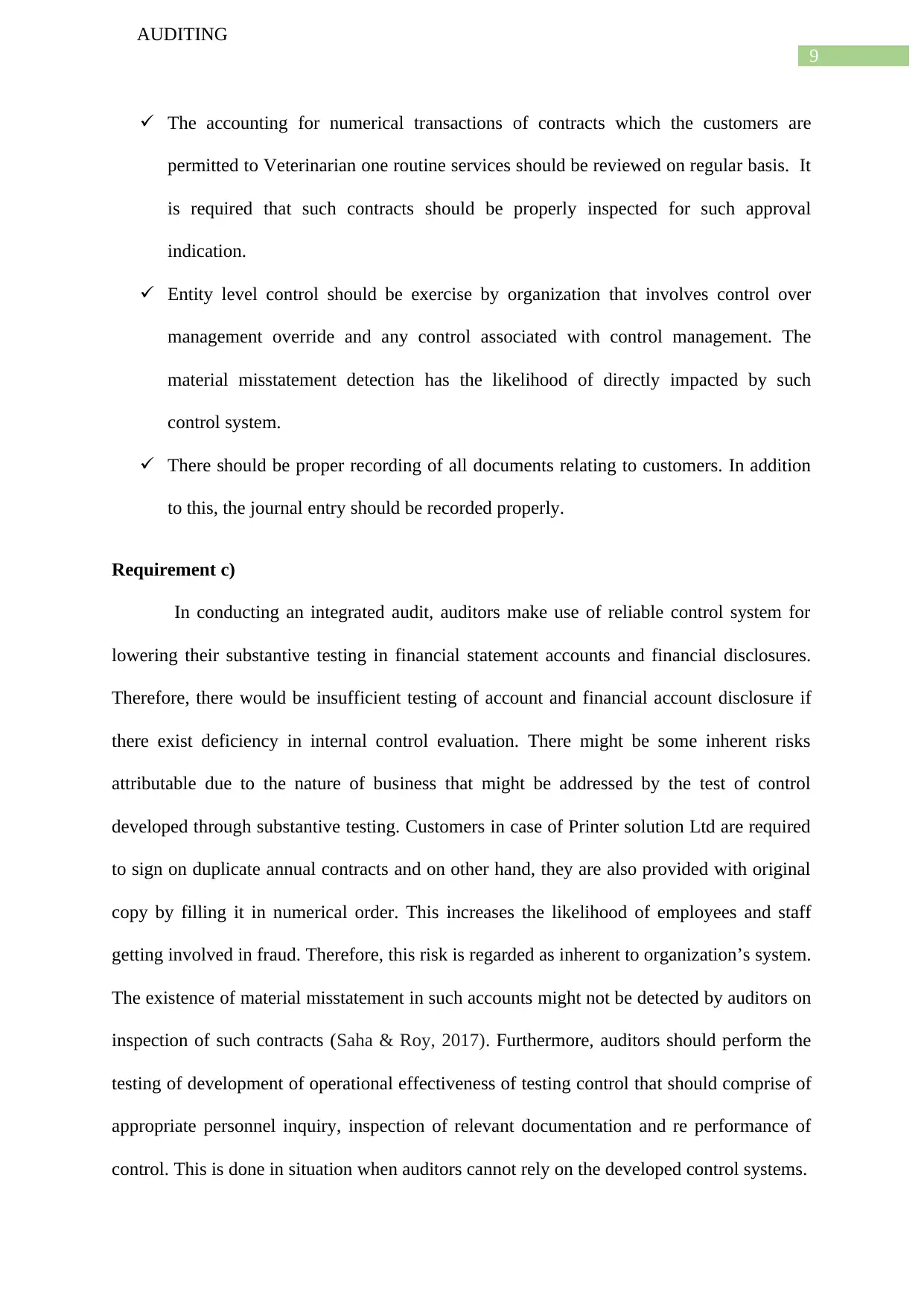
9
AUDITING
The accounting for numerical transactions of contracts which the customers are
permitted to Veterinarian one routine services should be reviewed on regular basis. It
is required that such contracts should be properly inspected for such approval
indication.
Entity level control should be exercise by organization that involves control over
management override and any control associated with control management. The
material misstatement detection has the likelihood of directly impacted by such
control system.
There should be proper recording of all documents relating to customers. In addition
to this, the journal entry should be recorded properly.
Requirement c)
In conducting an integrated audit, auditors make use of reliable control system for
lowering their substantive testing in financial statement accounts and financial disclosures.
Therefore, there would be insufficient testing of account and financial account disclosure if
there exist deficiency in internal control evaluation. There might be some inherent risks
attributable due to the nature of business that might be addressed by the test of control
developed through substantive testing. Customers in case of Printer solution Ltd are required
to sign on duplicate annual contracts and on other hand, they are also provided with original
copy by filling it in numerical order. This increases the likelihood of employees and staff
getting involved in fraud. Therefore, this risk is regarded as inherent to organization’s system.
The existence of material misstatement in such accounts might not be detected by auditors on
inspection of such contracts (Saha & Roy, 2017). Furthermore, auditors should perform the
testing of development of operational effectiveness of testing control that should comprise of
appropriate personnel inquiry, inspection of relevant documentation and re performance of
control. This is done in situation when auditors cannot rely on the developed control systems.
AUDITING
The accounting for numerical transactions of contracts which the customers are
permitted to Veterinarian one routine services should be reviewed on regular basis. It
is required that such contracts should be properly inspected for such approval
indication.
Entity level control should be exercise by organization that involves control over
management override and any control associated with control management. The
material misstatement detection has the likelihood of directly impacted by such
control system.
There should be proper recording of all documents relating to customers. In addition
to this, the journal entry should be recorded properly.
Requirement c)
In conducting an integrated audit, auditors make use of reliable control system for
lowering their substantive testing in financial statement accounts and financial disclosures.
Therefore, there would be insufficient testing of account and financial account disclosure if
there exist deficiency in internal control evaluation. There might be some inherent risks
attributable due to the nature of business that might be addressed by the test of control
developed through substantive testing. Customers in case of Printer solution Ltd are required
to sign on duplicate annual contracts and on other hand, they are also provided with original
copy by filling it in numerical order. This increases the likelihood of employees and staff
getting involved in fraud. Therefore, this risk is regarded as inherent to organization’s system.
The existence of material misstatement in such accounts might not be detected by auditors on
inspection of such contracts (Saha & Roy, 2017). Furthermore, auditors should perform the
testing of development of operational effectiveness of testing control that should comprise of
appropriate personnel inquiry, inspection of relevant documentation and re performance of
control. This is done in situation when auditors cannot rely on the developed control systems.
⊘ This is a preview!⊘
Do you want full access?
Subscribe today to unlock all pages.

Trusted by 1+ million students worldwide
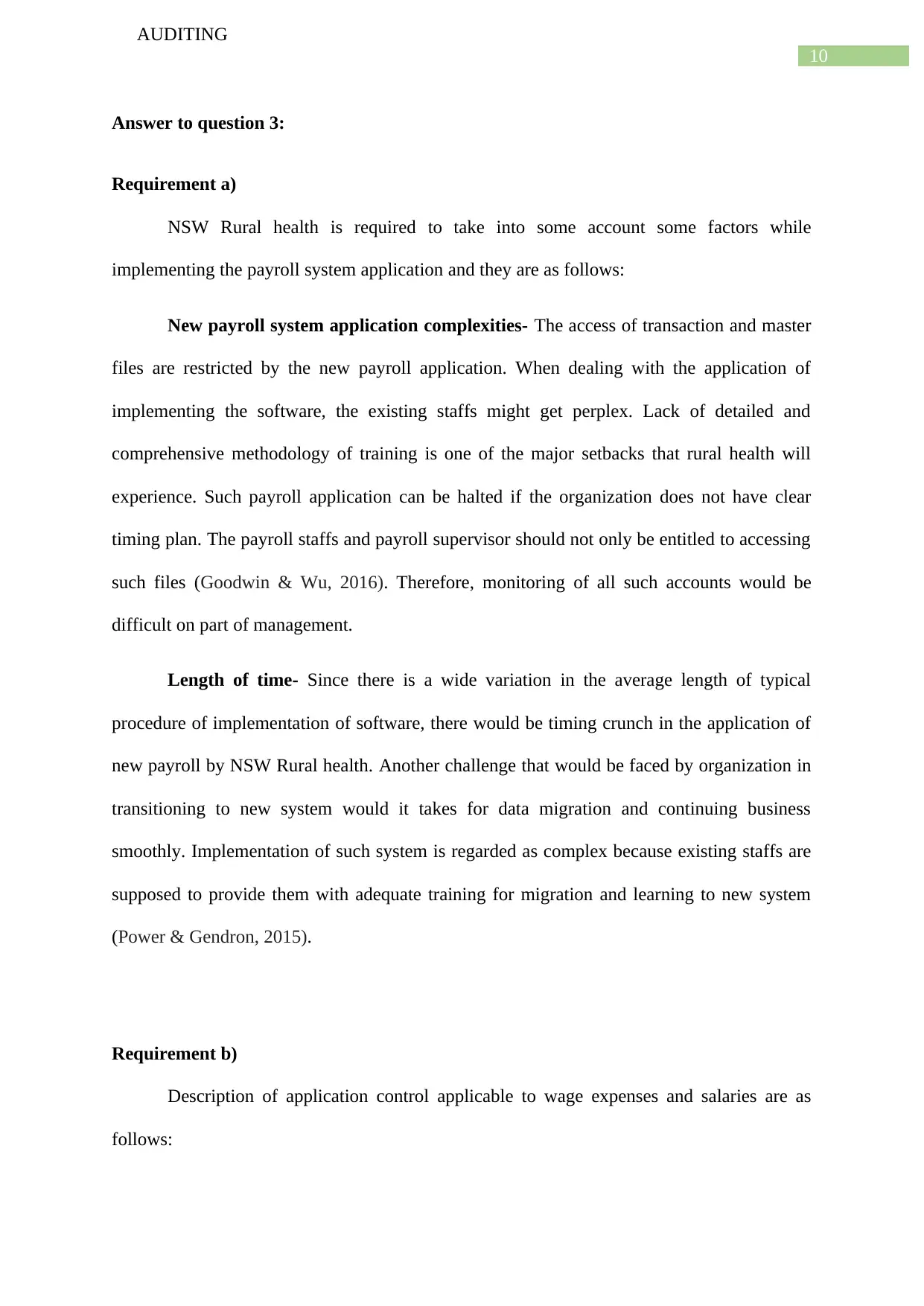
10
AUDITING
Answer to question 3:
Requirement a)
NSW Rural health is required to take into some account some factors while
implementing the payroll system application and they are as follows:
New payroll system application complexities- The access of transaction and master
files are restricted by the new payroll application. When dealing with the application of
implementing the software, the existing staffs might get perplex. Lack of detailed and
comprehensive methodology of training is one of the major setbacks that rural health will
experience. Such payroll application can be halted if the organization does not have clear
timing plan. The payroll staffs and payroll supervisor should not only be entitled to accessing
such files (Goodwin & Wu, 2016). Therefore, monitoring of all such accounts would be
difficult on part of management.
Length of time- Since there is a wide variation in the average length of typical
procedure of implementation of software, there would be timing crunch in the application of
new payroll by NSW Rural health. Another challenge that would be faced by organization in
transitioning to new system would it takes for data migration and continuing business
smoothly. Implementation of such system is regarded as complex because existing staffs are
supposed to provide them with adequate training for migration and learning to new system
(Power & Gendron, 2015).
Requirement b)
Description of application control applicable to wage expenses and salaries are as
follows:
AUDITING
Answer to question 3:
Requirement a)
NSW Rural health is required to take into some account some factors while
implementing the payroll system application and they are as follows:
New payroll system application complexities- The access of transaction and master
files are restricted by the new payroll application. When dealing with the application of
implementing the software, the existing staffs might get perplex. Lack of detailed and
comprehensive methodology of training is one of the major setbacks that rural health will
experience. Such payroll application can be halted if the organization does not have clear
timing plan. The payroll staffs and payroll supervisor should not only be entitled to accessing
such files (Goodwin & Wu, 2016). Therefore, monitoring of all such accounts would be
difficult on part of management.
Length of time- Since there is a wide variation in the average length of typical
procedure of implementation of software, there would be timing crunch in the application of
new payroll by NSW Rural health. Another challenge that would be faced by organization in
transitioning to new system would it takes for data migration and continuing business
smoothly. Implementation of such system is regarded as complex because existing staffs are
supposed to provide them with adequate training for migration and learning to new system
(Power & Gendron, 2015).
Requirement b)
Description of application control applicable to wage expenses and salaries are as
follows:
Paraphrase This Document
Need a fresh take? Get an instant paraphrase of this document with our AI Paraphraser
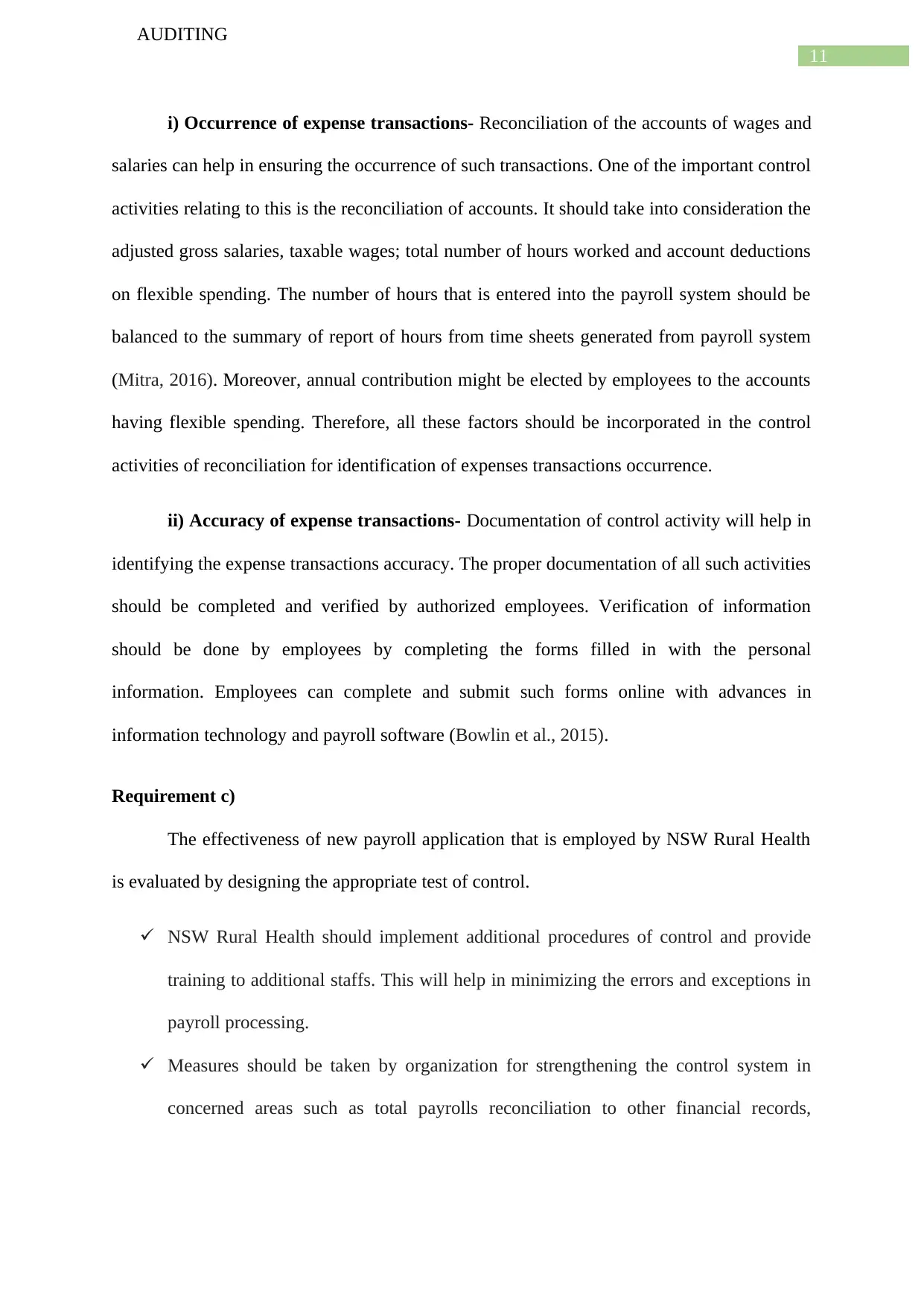
11
AUDITING
i) Occurrence of expense transactions- Reconciliation of the accounts of wages and
salaries can help in ensuring the occurrence of such transactions. One of the important control
activities relating to this is the reconciliation of accounts. It should take into consideration the
adjusted gross salaries, taxable wages; total number of hours worked and account deductions
on flexible spending. The number of hours that is entered into the payroll system should be
balanced to the summary of report of hours from time sheets generated from payroll system
(Mitra, 2016). Moreover, annual contribution might be elected by employees to the accounts
having flexible spending. Therefore, all these factors should be incorporated in the control
activities of reconciliation for identification of expenses transactions occurrence.
ii) Accuracy of expense transactions- Documentation of control activity will help in
identifying the expense transactions accuracy. The proper documentation of all such activities
should be completed and verified by authorized employees. Verification of information
should be done by employees by completing the forms filled in with the personal
information. Employees can complete and submit such forms online with advances in
information technology and payroll software (Bowlin et al., 2015).
Requirement c)
The effectiveness of new payroll application that is employed by NSW Rural Health
is evaluated by designing the appropriate test of control.
NSW Rural Health should implement additional procedures of control and provide
training to additional staffs. This will help in minimizing the errors and exceptions in
payroll processing.
Measures should be taken by organization for strengthening the control system in
concerned areas such as total payrolls reconciliation to other financial records,
AUDITING
i) Occurrence of expense transactions- Reconciliation of the accounts of wages and
salaries can help in ensuring the occurrence of such transactions. One of the important control
activities relating to this is the reconciliation of accounts. It should take into consideration the
adjusted gross salaries, taxable wages; total number of hours worked and account deductions
on flexible spending. The number of hours that is entered into the payroll system should be
balanced to the summary of report of hours from time sheets generated from payroll system
(Mitra, 2016). Moreover, annual contribution might be elected by employees to the accounts
having flexible spending. Therefore, all these factors should be incorporated in the control
activities of reconciliation for identification of expenses transactions occurrence.
ii) Accuracy of expense transactions- Documentation of control activity will help in
identifying the expense transactions accuracy. The proper documentation of all such activities
should be completed and verified by authorized employees. Verification of information
should be done by employees by completing the forms filled in with the personal
information. Employees can complete and submit such forms online with advances in
information technology and payroll software (Bowlin et al., 2015).
Requirement c)
The effectiveness of new payroll application that is employed by NSW Rural Health
is evaluated by designing the appropriate test of control.
NSW Rural Health should implement additional procedures of control and provide
training to additional staffs. This will help in minimizing the errors and exceptions in
payroll processing.
Measures should be taken by organization for strengthening the control system in
concerned areas such as total payrolls reconciliation to other financial records,
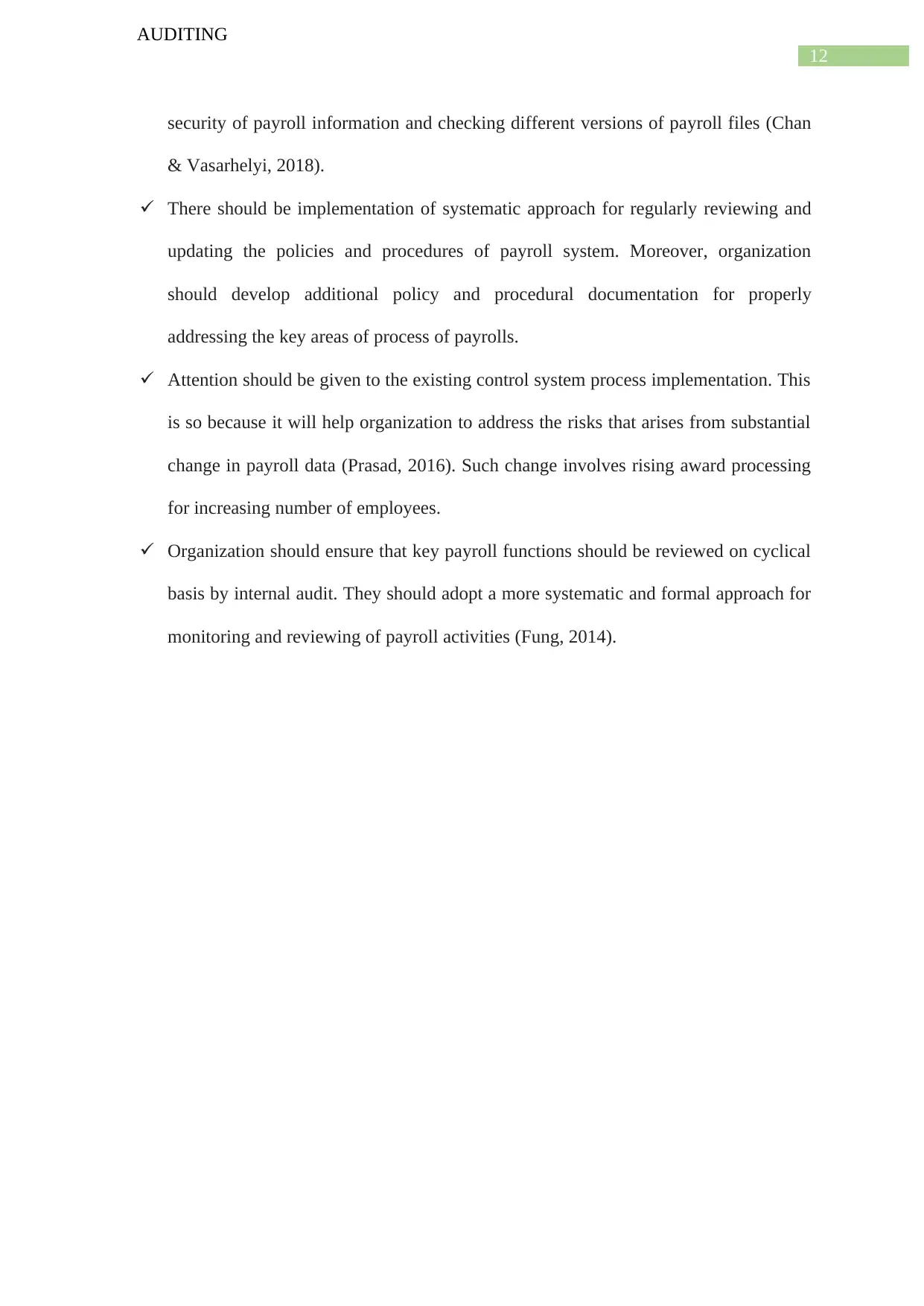
12
AUDITING
security of payroll information and checking different versions of payroll files (Chan
& Vasarhelyi, 2018).
There should be implementation of systematic approach for regularly reviewing and
updating the policies and procedures of payroll system. Moreover, organization
should develop additional policy and procedural documentation for properly
addressing the key areas of process of payrolls.
Attention should be given to the existing control system process implementation. This
is so because it will help organization to address the risks that arises from substantial
change in payroll data (Prasad, 2016). Such change involves rising award processing
for increasing number of employees.
Organization should ensure that key payroll functions should be reviewed on cyclical
basis by internal audit. They should adopt a more systematic and formal approach for
monitoring and reviewing of payroll activities (Fung, 2014).
AUDITING
security of payroll information and checking different versions of payroll files (Chan
& Vasarhelyi, 2018).
There should be implementation of systematic approach for regularly reviewing and
updating the policies and procedures of payroll system. Moreover, organization
should develop additional policy and procedural documentation for properly
addressing the key areas of process of payrolls.
Attention should be given to the existing control system process implementation. This
is so because it will help organization to address the risks that arises from substantial
change in payroll data (Prasad, 2016). Such change involves rising award processing
for increasing number of employees.
Organization should ensure that key payroll functions should be reviewed on cyclical
basis by internal audit. They should adopt a more systematic and formal approach for
monitoring and reviewing of payroll activities (Fung, 2014).
⊘ This is a preview!⊘
Do you want full access?
Subscribe today to unlock all pages.

Trusted by 1+ million students worldwide
1 out of 14
Related Documents
Your All-in-One AI-Powered Toolkit for Academic Success.
+13062052269
info@desklib.com
Available 24*7 on WhatsApp / Email
![[object Object]](/_next/static/media/star-bottom.7253800d.svg)
Unlock your academic potential
Copyright © 2020–2025 A2Z Services. All Rights Reserved. Developed and managed by ZUCOL.





